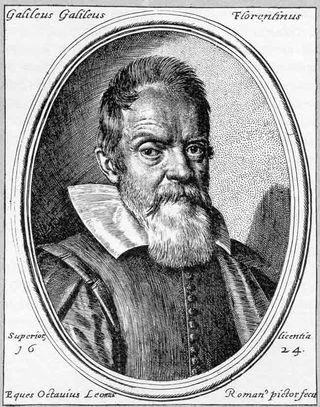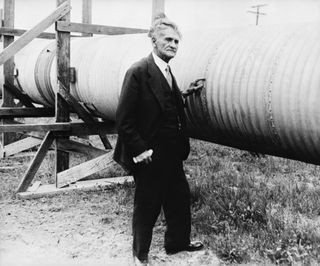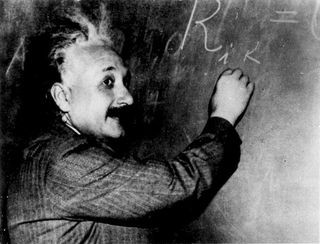Curious about how fast light travels in space? The speed of light is a fundamental constant of the universe, influencing everything from our understanding of time and space to the possibilities of interstellar travel. SIXT.VN understands the importance of exploring the universe and is here to illuminate this fascinating topic for all travel enthusiasts and aspiring astronauts. Discover the secrets of light speed and its implications for future space exploration and your next adventure.
1. What is the Speed of Light?
The speed of light in a vacuum is exactly 299,792,458 meters per second (approximately 186,282 miles per second). This constant, often denoted as “c” in equations, is a cornerstone of modern physics, particularly in Einstein’s theory of special relativity.
 Abstract, futuristic image of blue light streaks radiating outward, giving the impression of rapid movement or traveling at high speed, inspired by the concept of faster-than-light travel
Abstract, futuristic image of blue light streaks radiating outward, giving the impression of rapid movement or traveling at high speed, inspired by the concept of faster-than-light travel
Why is the Speed of Light Important?
According to Albert Einstein’s special relativity theory, nothing can travel faster than light. As matter approaches the speed of light, its mass becomes infinite, making light speed a universal speed limit. This concept has profound implications for our understanding of the universe and the possibilities of space travel. SIXT.VN is committed to providing you with accurate and insightful information, ensuring you stay informed about the latest scientific discoveries and travel innovations.
2. How is the Speed of Light Measured?
The speed of light is not just a theoretical concept; it’s a measurable quantity used to define international standard measurements, such as the meter. The U.S. National Institute of Standards and Technology (NIST) relies on the speed of light to maintain precise measurement standards.
What is a Light-Year?
A light-year is the distance light travels in one year, approximately 6 trillion miles (10 trillion kilometers). It’s a vital unit for astronomers and physicists measuring vast distances across the universe. For instance, light from the Moon reaches us in about 1 second, while sunlight takes around 8 minutes. Alpha Centauri, the nearest star system, is about 4.3 light-years away.
SIXT.VN encourages you to ponder these cosmic distances as you plan your next journey, whether it’s across continents or just across town.
3. What are the Implications of the Speed of Light?
The speed of light has significant implications for astronomy and our understanding of the universe’s history. When astronomers observe distant objects, they see light that shows these objects as they existed when the light left them. This allows us to see the universe as it looked shortly after the Big Bang, which occurred approximately 13.8 billion years ago.
How Does This Affect Our View of the Universe?
Objects 10 billion light-years away appear to astronomers as they were 10 billion years ago, offering a glimpse into the universe’s infancy. This principle is crucial for understanding the cosmos’ evolution and structure.
4. Is the Speed of Light Constant?
The speed of light is a universal constant in a vacuum, such as outer space. However, it can slow down slightly when passing through an absorbing medium like water or glass.
How Does the Medium Affect the Speed of Light?
When light passes through water, its speed decreases to approximately 225,000 kilometers per second (140,000 miles per second). In glass, it slows further to about 200,000 kilometers per second (124,000 miles per second). These variations highlight how different materials interact with light.
5. Who Discovered the Speed of Light?
One of the first measurements of the speed of light was made by Ole Rømer in 1676 through observations of Jupiter’s moons. Later, the Michelson-Morley Experiment in 1879 measured the speed of light with high precision.
How Did Rømer Measure the Speed of Light?
Rømer observed the eclipses of Jupiter’s moon Io and noted that the eclipses occurred slightly earlier when Jupiter was closer to Earth and later when Jupiter was farther away. He attributed this to the time it takes light to travel the varying distances, providing an early estimate of light’s speed.
 Galileo Galilei is credited with discovering the first four moons of Jupiter.
Galileo Galilei is credited with discovering the first four moons of Jupiter.
6. How Did We Learn About the Speed of Light?
Philosophers and physicists have contemplated the speed of light for centuries. Early ideas ranged from Aristotle’s belief that light was instantaneous to Empedocles’ suggestion that light travels at a finite rate.
What Were Early Attempts to Measure Light Speed?
In the mid-1600s, Galileo Galilei attempted to measure the speed of light using lanterns on distant hills. However, the distance was too short to produce accurate results. He concluded that light traveled at least 10 times faster than sound.
What Was Rømer’s Breakthrough?
In the 1670s, Danish astronomer Ole Rømer, while trying to create a reliable timetable for sailors, noticed variations in the timing of eclipses of Jupiter’s moon Io. He correctly deduced that light takes measurable time to travel from Io to Earth, estimating the speed of light at about 124,000 miles per second (200,000 km/s).
How Did Later Scientists Refine the Measurement?
In 1728, English physicist James Bradley refined the calculation based on the change in the apparent position of stars due to Earth’s orbit around the Sun, estimating the speed of light at 185,000 miles per second (301,000 km/s), accurate to within 1%.
In the mid-1800s, French physicists Hippolyte Fizeau and Leon Foucault independently used terrestrial experiments involving rotating toothed wheels and mirrors to refine the measurement further.
7. How Did Michelson Contribute to Our Understanding?
Albert A. Michelson dedicated much of his career to studying the speed of light. In 1879, he replicated Foucault’s method with improved equipment, achieving a result of 186,355 miles per second (299,910 km/s). He later conducted experiments in a mile-long vacuum tube to minimize the effect of air on light speed, further refining the measurement.
 Dr. Albert A. Michelson stands next to a large tube supported by wooden beams.
Dr. Albert A. Michelson stands next to a large tube supported by wooden beams.
What Was the Michelson-Morley Experiment?
Michelson, along with Edward Morley, conducted the famous Michelson-Morley experiment to detect the “luminiferous aether,” a hypothetical medium through which light was thought to travel. The experiment failed to detect the aether, leading to the conclusion that light can travel through a vacuum. This non-discovery revolutionized physics, earning Michelson a Nobel Prize.
8. How Does Special Relativity Relate to the Speed of Light?
Einstein’s theory of special relativity unifies energy, matter, and the speed of light in the equation E = mc^2. This equation demonstrates that small amounts of mass contain an immense amount of energy, with the speed of light serving as a conversion factor.
 Albert Einstein writing on a blackboard.
Albert Einstein writing on a blackboard.
Why is the Speed of Light a Constant in Relativity?
Einstein asserted that light moves through a vacuum at the same speed regardless of the observer’s motion. This principle is essential for the consistency of special relativity. Objects with mass cannot reach the speed of light because their mass would become infinite, requiring infinite energy to move them.
9. What Expands Faster Than the Speed of Light?
Although the speed of light is the universe’s speed limit for objects within space, the universe itself expands faster. The universe expands at a rate of about 42 miles (68 kilometers) per second for each megaparsec (3.26 million light-years) of distance from the observer.
How Can the Universe Expand Faster Than Light?
Special relativity provides a speed limit within the universe, but general relativity allows different behavior when considering physics on a cosmic scale. Distant galaxies can recede from us at speeds exceeding the speed of light due to the expansion of space itself.
10. Does Light Ever Slow Down?
Light travels at its maximum speed in a vacuum, but it slows down when passing through materials. The amount of slowing is quantified by the material’s refractive index.
 A sparkling diamond amongst dark coal-like rock.
A sparkling diamond amongst dark coal-like rock.
How Do Different Materials Affect Light Speed?
For example, light slows slightly in Earth’s atmosphere, but it significantly slows in diamond, reaching less than half its vacuum speed. Researchers have also demonstrated that light can be trapped and even stopped in ultra-cold clouds of atoms or at “exceptional points” where light emissions intersect.
11. Can We Travel Faster Than Light?
The idea of faster-than-light travel is a staple of science fiction, making interstellar travel feasible in stories. However, achieving this in reality would require harnessing exotic physics.
What Are the Theoretical Possibilities for Faster-Than-Light Travel?
One concept involves manipulating space-time to create a “warp drive” that could move space around a spaceship, rather than moving the ship itself through space. This would bypass the limitations imposed by special relativity.
Why is Faster-Than-Light Travel Important?
Without faster-than-light travel, reaching even the nearest star systems would take tens of thousands of years. Overcoming this barrier would revolutionize space exploration, allowing humanity to reach the farthest corners of the universe.
12. How Can SIXT.VN Enhance Your Travel Experiences?
While faster-than-light travel remains in the realm of science fiction, SIXT.VN is dedicated to making your real-world travel experiences as seamless and enjoyable as possible. Whether you’re exploring the vibrant streets of Hanoi or venturing into the serene landscapes of Vietnam, our comprehensive services cater to all your travel needs.
What Services Does SIXT.VN Offer?
- Tailored Travel Itineraries: We design personalized itineraries to match your interests and schedule, ensuring you make the most of your trip.
- Airport Transfers: Enjoy hassle-free airport transfers with our reliable and comfortable service, starting your journey on the right foot.
- Hotel Bookings: Choose from a wide range of hotels that fit your budget and preferences, ensuring a comfortable and convenient stay.
- Attraction Tickets: Skip the lines and secure your tickets to the most popular attractions in Hanoi and beyond.
- Flight Bookings: Find the best deals on flights with flexible scheduling options, making your travel planning easier than ever.
- Guided Tours: Explore Hanoi with our expert-led tours, uncovering the city’s rich history and culture.
13. How Can SIXT.VN Solve Your Travel Challenges in Vietnam?
We understand the challenges that travelers face when visiting a new country. Language barriers, unfamiliar transportation systems, and the need for reliable services can be daunting. SIXT.VN addresses these challenges by providing:
- Expert Travel Advice: Our team offers in-depth knowledge and personalized advice to help you navigate your trip.
- Convenient Airport Transfers: Avoid the stress of finding transportation upon arrival with our pre-booked airport transfer service.
- Wide Range of Accommodation Options: We offer a variety of hotels to suit different budgets and preferences, ensuring a comfortable stay.
- Curated Tour Packages: Discover the best of Hanoi and surrounding areas with our thoughtfully designed tour packages.
- Easy Booking Process: Our user-friendly website makes it simple to book all your travel needs in one place.
14. Why Choose SIXT.VN for Your Hanoi Adventure?
SIXT.VN offers unparalleled convenience, reliability, and support, making us the ideal partner for your travel adventures in Vietnam.
What are the Benefits of Using SIXT.VN?
- Convenience: Book all your travel services in one place, saving time and effort.
- Reliability: Count on our dependable services to ensure a smooth and stress-free trip.
- Expert Support: Our team is available to assist you with any questions or concerns, providing peace of mind.
- Local Expertise: Benefit from our in-depth knowledge of Hanoi and Vietnam, uncovering hidden gems and authentic experiences.
- Customized Experiences: Tailor your trip to your interests and preferences, creating a unique and memorable adventure.
15. Call to Action: Start Planning Your Trip with SIXT.VN
Ready to explore the beauty and culture of Hanoi? Let SIXT.VN take care of all your travel needs.
How Can You Get Started?
Visit our website at SIXT.VN to explore our wide range of services and packages. Contact us today to start planning your unforgettable journey to Vietnam!
Address: 260 Cau Giay, Hanoi, Vietnam
Hotline/WhatsApp: +84 986 244 358
Website: SIXT.VN
16. FAQ: Frequently Asked Questions About the Speed of Light
1. What is the exact speed of light in a vacuum?
The speed of light in a vacuum is precisely 299,792,458 meters per second (approximately 186,282 miles per second). This is a fundamental constant of the universe.
2. Why is the speed of light so important in physics?
The speed of light is crucial because it is the ultimate speed limit of the universe, according to Einstein’s theory of special relativity. It also relates energy and mass through the famous equation E = mc^2.
3. Can anything travel faster than the speed of light?
According to our current understanding of physics, nothing with mass can travel faster than the speed of light. However, the universe itself can expand faster than the speed of light.
4. Does light travel at the same speed in all materials?
No, light travels at its maximum speed in a vacuum. When it passes through materials, it slows down, and the extent of slowing depends on the material’s refractive index.
5. Who first measured the speed of light accurately?
Ole Rømer made one of the first estimates by observing Jupiter’s moons. Albert A. Michelson refined the measurement through terrestrial experiments.
6. What is a light-year, and why do astronomers use it?
A light-year is the distance light travels in one year, about 6 trillion miles. Astronomers use it to measure the vast distances between stars and galaxies.
7. How did Einstein’s theory of relativity change our understanding of the speed of light?
Einstein’s theory of special relativity established that the speed of light is constant for all observers, regardless of their motion.
8. Is it possible to stop light completely?
Yes, scientists have demonstrated that light can be trapped and even stopped in ultra-cold clouds of atoms or at exceptional points where light emissions intersect.
9. What are the theoretical possibilities for faster-than-light travel?
One theoretical possibility is to manipulate space-time using a “warp drive,” which would move space around a spaceship rather than moving the ship through space.
10. How does the speed of light affect our ability to observe distant objects in the universe?
When we observe distant objects, we see them as they were when the light left them. This allows us to study the history of the universe by observing objects at different distances.



